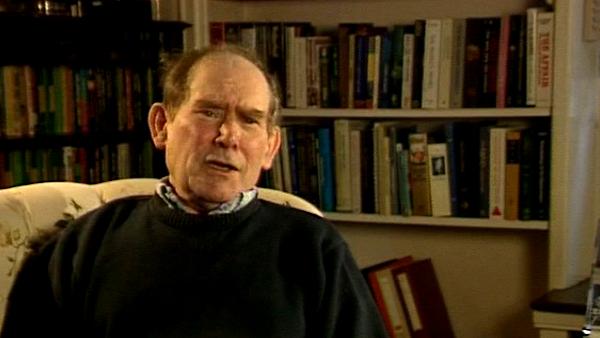NEXT STORY

The real concept of the DNA code
RELATED STORIES

NEXT STORY

The real concept of the DNA code
RELATED STORIES


|
Views | Duration | |
|---|---|---|---|
| 51. Taking advantage of Oxford University | 476 | 02:52 | |
| 52. Professor Dawkins and Quest for Corvo | 680 | 03:54 | |
| 53. The surprise of England | 427 | 02:11 | |
| 54. My secret input into the DNA model | 515 | 03:39 | |
| 55. The DNA model: the beginning of molecular biology | 1 | 581 | 03:39 |
| 56. Crick, Watson and the first model of the double helix | 574 | 02:20 | |
| 57. The first and second DNA structure papers | 665 | 04:17 | |
| 58. The real concept of the DNA code | 708 | 01:21 | |
| 59. Understanding the DNA model | 450 | 02:20 | |
| 60. Impressions of Watson and Crick | 911 | 03:54 |


The first paper just defined the structure, and this… and had nothing to do about the explanation of mutation and replication and so on. And then there was a second paper which did that. The first paper just said, 'We have… invented a… the structure of the one', and it has this last sentence: 'It has not escaped our attention'. And that is simply because that was published side by side with the Wilkins-Franklin thing, you see, so it was just the structure. And then they put in this caveat phrase, and then they wrote a second paper which, by the way, nobody actually seems to have digested. Everybody compresses both. The second paper is the one that shows… discusses replication, discusses the problem of the unwinding of the chains, discusses it as the mechanism of mutation, the tautomers and so on, and also raises all the questions of the code, you see. And that I think was the most… so it is the biological consequences of the model which now, I mean, you know, in retrospect people have compressed into… into the model. And naturally it was that that made it attractive. And one of the interesting things that emerged from that is that of course most people at the time would have been… said that you've got to unwind the chains, and that looks impossible, to copy the structure. And it… and they would have eliminated the… the structure on the grounds that the chains were not parallel but… were not parallel coiled, but intertwined. But of course that's the first time you… you know, that it dawned upon me that… that the impulse of the theory could be so strong that all you needed is what I became... to call later a Don't Worry hypothesis. Now, a Don't Worry hypothesis, which is very important in biology, is to just provide one plausible way that this could be done, and then you don't have to worry about it, and then you can just get on with the real thing, and one plausible way, which we postulated and I can remember the conversation, is that there'll be an enzyme to do it. Which of course there are. They're called helicases and they break chains and rejoin them. And so this is the first of the many Don't Worry hypotheses that we generated in the early days of molecular biology in order to lessen the constraints on... on theory. The trouble with a lot of biology is that it is very hard for theory to be so compelling that in fact you would be willing to ignore certain facts. And in order to do this you have to have hypotheses that... that can allow you not of course to ignore facts, but in fact to deal with what seem to be difficulties, but which can be resolved and in many cases this provides the most fruitful approach, rather than rejecting it out of hand as impossible. You see that, many people said, 'You can't... you have to have separate genes for folding'. Right. So that… so that… polypeptide is just inconceivable, it would fold up by itself. And I think there are many examples in this that in fact you just say, 'Well, look, don't worry about this, you know; this will be resolved'. How else do you expect it to be done? It's done with no hands. And the unwinding, I think, was one of the things.
South African Sydney Brenner (1927-2019) was awarded the Nobel Prize in Physiology or Medicine in 2002. His joint discovery of messenger RNA, and, in more recent years, his development of gene cloning, sequencing and manipulation techniques along with his work for the Human Genome Project have led to his standing as a pioneer in the field of genetics and molecular biology.
Title: The first and second DNA structure papers
Listeners: Lewis Wolpert
Lewis Wolpert is Professor of Biology as Applied to Medicine in the Department of Anatomy and Developmental Biology of University College, London. His research interests are in the mechanisms involved in the development of the embryo. He was originally trained as a civil engineer in South Africa but changed to research in cell biology at King's College, London in 1955. He was made a Fellow of the Royal Society in 1980 and awarded the CBE in 1990. He was made a Fellow of the Royal Society of Literature in 1999. He has presented science on both radio and TV and for five years was Chairman of the Committee for the Public Understanding of Science.
Tags: Molecular structure of nucleic acids, A structure for deoxyribose nucleic acid, Maurice Wilkins, Rosalind Franklin
Duration: 4 minutes, 18 seconds
Date story recorded: April-May 1994
Date story went live: 24 January 2008